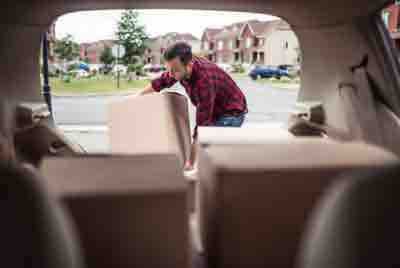Should you increase the pressure in your tires when the weight of your car increases or should you just leave it as it is?
Yes, you should increase the air pressure in your tires when you are carrying a heavy load. In fact, it is advisable that you adjust the air pressure in your tires according to the weight at various times.
It is perfectly okay to inflate your tires to a pressure more than the normal pressure when you are carrying a heavy load or carrying more passengers than usual.
However, you are required to inflate with discretion because every tire has a maximum weight that it can carry and an appropriate air pressure for the weight.
The appropriate pressure to inflate your tires will be indicated in your vehicle’s owner’s manual.
Adding a little bit of extra air to your tires can prove to be beneficial if you will be carrying more than the normal weight.
The increase in air pressure could make your tires more stable as you drive with that excess weight.
Do note that it is important that you have a matching PSI in both the front and back tires in order to have a smooth ride.
Please make sure that you remember to reduce the pressure in your tires after the vehicle has returned to its normal weight.
Table of Contents
Should I increase tire pressure when towing?
Having agreed that towing is a heavy-duty job for your vehicle, it is important to know that your tires need to be inflated to the maximum cold pressure shown on the sidewall of the tire.
The pressure in your tires reduces at a rate of 2 psi per month, and this rate can increase during warm weather conditions so on average, your tires lose air pressure faster during summertime.
During this time, ensure you constantly keep an eye on your tires so you can increase the air pressure when necessary before using the vehicle to tow.
Towing requires that the air pressure in your tires is increased so that the tires can handle and carry the heavyweight but there is a thin line between increasing the air pressure in your tires and overinflating your tires.
Do not overinflate in your tires because that can prove to be very costly. A tire that is overinflated will have a smaller contact area on the ground as you drive and this will ultimately lead to poor handling and loss of traction.
Overinflating your tires will make braking very bad and the tire will wear heavily across the center of the tread, and all these will make the tires unsafe to drive on.
Increase tire pressure when towing but be careful to not overinflate.
What should your tire pressure be when towing?
Towing can be a really hard job to do for your vehicle and it is important that you pay attention to the air pressure in your vehicle before using it as a tow vehicle.
So, what is the right air pressure to have in your tires when you want to tow?
There is not a generally accepted air pressure to use when towing but it is widely advised that you check your vehicle’s owner’s manual for professional recommendations from the manufacturers.
There are a couple of recommendations and I will be sharing some of them.
To answer the question: should I increase tire pressure for a heavy load? It is a Yes! Yes, You should increase your tire pressure for a heavy load but, you need to know the limit as discussed below.
The appropriate tire pressure for towing is 32-38 PSI. I also advise that you increase the air pressure in your rear tires to about 4psi more than the front tires so that they can adequately cope with the extra load on the tow ball.
Protyre.co.uk advised that you should set the air pressure in your rear tires to full load pressure. You can also add 4-7 psi to it because of the heavy extra weight.
Cilinsurance.com.au noted that it is unwise to inflate your tires above 45psi but for towing conditions, the rear tires should be inflated to near their maximum and this is because they carry the greater part of the load when towing.
From this, we can gather that your tire pressure would need to be quite high when using your vehicle to tow.
What PSI should my trailer tires be?
Driving heavy vehicles like trucks, trailers or even tractors means that the rules of air pressure that apply to normal cars may be different to you.
For a normal vehicle (car), the average psi is 32 psi to 35 PSI. This means that a car that runs on tires with air pressure within this range is doing fine. But can the same be said for a trailer or truck?
Trucks and trailers are primarily used for heavy lifting and since we know that the loads they carry may vary, it is important to use the load/inflation table published by any tire manufacturer to determine the appropriate tire pressure.
Unlike cars and minivans that have low air pressure prescribed, heavy trucks require very high air pressure.
There have been various recommendations but the best ones are; 55 psi for front tires and 80 psi for rear tires; 75 psi for both front and back tires; 50 psi for tires at the front and 65 psi for tires at the back.
These high air pressures are necessary for the trucks to do their job and even if you want to adjust the air pressures to your taste, ensure that you do not put less air in the rear of a truck.
How to know that your tires are overinflated?

Like I mentioned earlier, there is a thin line between increasing the air pressure in your tires and overinflating your tires. Here are some tips to help you know when you have overinflated your tires.
There are four major signs and symptoms that alert you of a possible overinflation in your tires.
They are; Lack of traction, wearing on center treads, uncomfortable drives, and odd behavior from your car.
Lack of Traction
One of the first signs you will get when your tires are overinflated is the loss of traction. The contact patch of the tires is what makes your car stand firm while driving on the road.
So, if your tires are overinflated, the contact patch becomes thin and small. A tire that is overinflated will have its center bulging and that means only the couple of inches in the center will be in contact with the road.
A small contact patch means less grip on the road. You can get a feel of this when you try to go round a corner and it feels like the car slides slightly.
Another way you know that you are losing traction is when your braking distances increase.
Wearing out of center tread
Your tires are overinflated if you notice that the center treads are significantly worn out than the outside and inside of the tire.
This occurs because driving on overinflated tires will make the center treads do most of the work and they will wear out faster than the other treads.
Uncomfortable Drive
Asides from losing traction and the center of your tires wearing out, another way to know that you have overinflated your tires is the rough rides you will be having.
When tires are overinflated, they become stiffer and almost inflexible, unlike tires that are at normal air pressure levels.
Overinflated tires will not absorb the shocks from hitting bumps and landing in potholes, rather they transfer the hits to you and the passengers.
Odd behavior from your car
Overinflating your tires could make your car behave a bit differently from usual. This is because systems like the ABS and traction control are developed to work with tires that are correctly inflated.
If you overinflate your tires, your electronic stability control systems will begin to act in odd ways because they will be picking up incorrect signals from the wheels and therefore try to control the car. This can be particularly dangerous.
These are just four of the main reasons for you to ensure that your tires are properly inflated.
What you should do to overinflated tires
Now that you know the signs to look out for when you suspect that you have an overinflated tire, what do you do when you find that overfilled tire? What are the remedies?
Having an overinflated tire is an occurrence that you will most likely experience during your years of driving but good news, it is not the end of the world.
You can fix the issue and here are the steps to take:
- Look for the tire valve stem.
- Take off the valve cap.
- Put the tire inflator or the pressure gauge on the valve stem. It is important that this is properly inserted so there is no air leaking beside it.
- After putting the tire inflator or pressure gauge on the valve stem, press the release valve until the gauge shows that the air pressure in the tire has reached the appropriate pressure.
- Once the air pressure has reached the appropriate or desirable level, return the valve cap on the valve stem and tighten it properly so air does not leak out while driving.
With these five (5) simple steps, you can easily turn your overinflated tires into properly inflated tires.
However, if the tire pressure gauge you have does not come with a release valve, then these are the steps you should take;
- Look for the tire valve stem.
- After finding the tire valve stem, take off the valve cap.
- After taking off the valve cap, firmly press the small pin that you will find in the middle of the valve. You should, preferably, use a small stick or a screwdriver – depending on what you can find around – to press down the pin. You should be careful about using a metal tool to press the pin so you do not cause damage to the valve. Once you press the pin, you will hear a hissing noise; that is the excess air coming out.
- When you let some air out to an extent, use the tire pressure gauge to know the air pressure still left in the tire. If it is still higher than the appropriate level, press the pin again. Keep doing this till let out all excess air and the tire pressure gauge reads the appropriate pressure.
- Once you are finished, return the valve back to the valve stem and tighten it properly to avoid air leaking out.
Similar Articles:
What Is the Difference Between 225 and 265 Tires?
Why Is My Tire Smoking and Smells Like Burning Rubber?
Cooper St Maxx vs Ridge Grapplers: Which is Better?
Cooper St Maxx vs BFG KO2: Which is Better?

